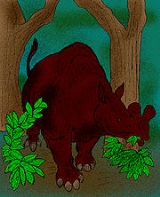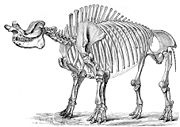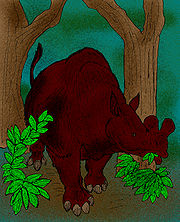
Brontops
Encyclopedia
Brontops is an extinct genus of rhinoceros
-like perissodactyl mammal.
According to one source, Brontops is subsumed into genus Megacerops
.

 A typical brontothere
A typical brontothere
, Brontops was a huge rhinoceros
-like creature standing 2.5 metres (8.2 ft) tall at the shoulder, though the species B. dispar, could be about the size of a modern-day white rhino. It looked similar to the better known Brontotherium
, possessing the same pair of blunt, horn
-like protrusions on its snout, though they were considerably shorter.
fractures, which supports the theory that males used their 'horns' to fight each other. No creature living in Brontopss time and area except another Brontops could have inflicted such an injury. The breathing movements prevented the fractures from completely healing. The adults may have also used their horns to defend themselves and their calves from predators, such as creodonts or nimravids.
Rhinoceros
Rhinoceros , also known as rhino, is a group of five extant species of odd-toed ungulates in the family Rhinocerotidae. Two of these species are native to Africa and three to southern Asia....
-like perissodactyl mammal.
According to one source, Brontops is subsumed into genus Megacerops
Megacerops
Megacerops is an extinct genus of the family Brontotheriidae endemic to North America during the Late Eocene epoch , existing for approximately .-Taxonomy:...
.
Appearance


Brontotheriidae
Brontotheriidae, also called Titanotheriidae, is a family of extinct mammals belonging to the order Perissodactyla, the order that includes horses, rhinoceroses, and tapirs. Superficially they looked rather like rhinos, although they were not true rhinos and are probably most closely related to...
, Brontops was a huge rhinoceros
Rhinoceros
Rhinoceros , also known as rhino, is a group of five extant species of odd-toed ungulates in the family Rhinocerotidae. Two of these species are native to Africa and three to southern Asia....
-like creature standing 2.5 metres (8.2 ft) tall at the shoulder, though the species B. dispar, could be about the size of a modern-day white rhino. It looked similar to the better known Brontotherium
Brontotherium
Brontotherium is an extinct genus of prehistoric odd-toed ungulate mammal of the family Brontotheriidae, an extinct group of rhinoceros-like browsers related to horses. The genus was found in North America during the Late Eocene....
, possessing the same pair of blunt, horn
Horn (anatomy)
A horn is a pointed projection of the skin on the head of various animals, consisting of a covering of horn surrounding a core of living bone. True horns are found mainly among the ruminant artiodactyls, in the families Antilocapridae and Bovidae...
-like protrusions on its snout, though they were considerably shorter.
Fighting
The skeleton of an adult male was found with partially healed ribRib
In vertebrate anatomy, ribs are the long curved bones which form the rib cage. In most vertebrates, ribs surround the chest, enabling the lungs to expand and thus facilitate breathing by expanding the chest cavity. They serve to protect the lungs, heart, and other internal organs of the thorax...
fractures, which supports the theory that males used their 'horns' to fight each other. No creature living in Brontopss time and area except another Brontops could have inflicted such an injury. The breathing movements prevented the fractures from completely healing. The adults may have also used their horns to defend themselves and their calves from predators, such as creodonts or nimravids.

